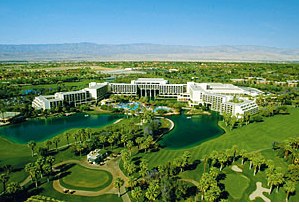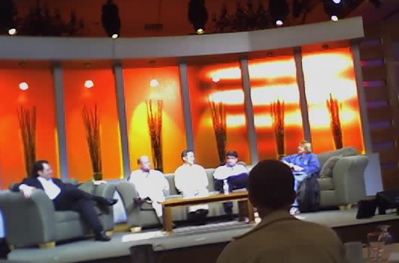Fellow innovation junkies, your day is fast approaching: it’s almost DEMO time again, and I can’t wait! You’ve heard me say before that this is simply the best tech conference there is, which is why I cover every single one of them. 
The anticipation for this event is like no other, not to speak of the surprises — with up to 70 new companies or products launching at each of the twice yearly conferences. This is where you see the new stuff. How does 2,380 company launches over 17 years of experience sound? It’s an amazing record. Through it all, as the DEMO folks say, their focus "remains on one thing: the future." Read more on the DEMO About page.
 So, yes, January 28-30, I’ll be in Palm Desert, CA, attending the DEMO ’08 conference as a member of the press corps again. And, as part of this prestigious group, I’ve been given the opportunity to offer Tech~Surf~Blog readers a special discount to attend.
So, yes, January 28-30, I’ll be in Palm Desert, CA, attending the DEMO ’08 conference as a member of the press corps again. And, as part of this prestigious group, I’ve been given the opportunity to offer Tech~Surf~Blog readers a special discount to attend.
You can get more than $600 off if you register through this special, whiz-bang link.  Click here for more DEMO information and conference details, and here’s a great FAQ page, too. (Just be aware that this discount cannot be combined with other offers or promotions, or applied to registrations that have already been processed.)
Click here for more DEMO information and conference details, and here’s a great FAQ page, too. (Just be aware that this discount cannot be combined with other offers or promotions, or applied to registrations that have already been processed.)
I really hope you can make it, because I love to meet my readers in person! And I know you will find it a valuable experience.
The thing about DEMO is that it’s so much fun, too. Here are some of the events. There’s nothing that beats partyin’ with your fellow innovation junkies (between blog posts, of course).
And the venue? Oh, baby, this place is awesome: the JW Marriott Desert Springs Resort, as you can see from a few pix I’ve included here. Click here as well for more about the hotel and travel details.
Here’s how the DEMO folks recently talked about their record over the years in picking winners. They do have an uncanny ability to uncover new trends:
"DEMO was there when the seeds of Web 2.0 were planted… exploring some
of the first Web services before we even had buzz words to describe
them. We have stayed true to our mission: to find great innovation
wherever it occurs, identify market trends through the lens of the
products coming to market, and expose you to new ideas and
opportunities."DEMO does not follow trends – we invent them.
Never has this been more apparent when the NBC Today Show segment on
January 1st featured Top Tech Trends for 2008 and highlighted two DEMO
Alumni who launched at previous DEMO events – Ugobe and Dash. It was
great to see companies making an impact on the market with technologies
identified by DEMO two years earlier."
Want to read some more good stuff about their predictions and trends for 2008? The DEMOblog is a great resource, written by the show’s executive producer, Chris Shipley, and edited by Keith Shaw. It’s one of the best kept secrets out there in blog-land, and is actually an online version of the venerable DEMOletter.
So, net-net — you really want to know what’s coming? Attend DEMO — simple as that. See you there if you can make it! And watch for my next post on the event, which will include a listing and links to all the presenting companies, just as soon as they’re announced to us press folk (the weekend before).
 But I was able to bop right into one session before lunch: “Open Source Business Models for Web2.0.” John Roberts, CEO and cofounder of SugarCRM, told us about the non-traditional way his company started: really as a project, then it wasn’t incorporated for almost two years. Funding came even later. “Companies are starting differently these days,” he said. Now, SugarCRM has 100+ employees, 1200 customers in 30 countries, 100,000 users, and 7000 registered developers. How are they 2.0? “We sell subscriptions, not licenses,” he said. “And, as Tim O’Reilly would define it, we trust our users as co-developers.”
But I was able to bop right into one session before lunch: “Open Source Business Models for Web2.0.” John Roberts, CEO and cofounder of SugarCRM, told us about the non-traditional way his company started: really as a project, then it wasn’t incorporated for almost two years. Funding came even later. “Companies are starting differently these days,” he said. Now, SugarCRM has 100+ employees, 1200 customers in 30 countries, 100,000 users, and 7000 registered developers. How are they 2.0? “We sell subscriptions, not licenses,” he said. “And, as Tim O’Reilly would define it, we trust our users as co-developers.”  individual websites to do global broadcasting.” What’s interesting now, Jeremy said, is that his firm is encountering an incredible willingness to experiment” (presumably by the traditional video distribution businesses, and by video producers). Why? “Out of fear, to pursue new revenue opportunities, just to stay out in front.” Esther asks what friction he’s seeing…. “It’s similar to the early days of e-commerce,” he said, “where manufacturers worried about going direct, then ended up discovering that blended distribution worked best. It’s the same now.” When asked what challenges he sees, Leonard Liu of Augmentum, whose firm is providing software development services for U.S. firms via a staff of 450 in China, says the challenges are many, including language. “But China is the next big player” in this space, he said. “We’ve seen in India what can happen. But it takes a true understanding of China — for example, the young people are different than the old — as far as how the cultures work together.” Liu said 60% of what his firm does is total product development, “from beginning to end.” Intel is one big customer. And how does Microsoft react, now that it isn’t such a target, Esther asked of the fourth panelist. “How can we marry all this friction-free software to the Windows environment,” was his obvious first answer. “But we see many opportunities — advertising, subscription models, Office Live. This is an exciting time, now that we’re unleashed to an extent. We think we’re responding well to what people want and don’t want.”
individual websites to do global broadcasting.” What’s interesting now, Jeremy said, is that his firm is encountering an incredible willingness to experiment” (presumably by the traditional video distribution businesses, and by video producers). Why? “Out of fear, to pursue new revenue opportunities, just to stay out in front.” Esther asks what friction he’s seeing…. “It’s similar to the early days of e-commerce,” he said, “where manufacturers worried about going direct, then ended up discovering that blended distribution worked best. It’s the same now.” When asked what challenges he sees, Leonard Liu of Augmentum, whose firm is providing software development services for U.S. firms via a staff of 450 in China, says the challenges are many, including language. “But China is the next big player” in this space, he said. “We’ve seen in India what can happen. But it takes a true understanding of China — for example, the young people are different than the old — as far as how the cultures work together.” Liu said 60% of what his firm does is total product development, “from beginning to end.” Intel is one big customer. And how does Microsoft react, now that it isn’t such a target, Esther asked of the fourth panelist. “How can we marry all this friction-free software to the Windows environment,” was his obvious first answer. “But we see many opportunities — advertising, subscription models, Office Live. This is an exciting time, now that we’re unleashed to an extent. We think we’re responding well to what people want and don’t want.” Businesses have a choice whether to lead the changes or resist them. But just deciding to respond isn’t that easy. You have to figure out how: how to put users in charge, how to listen, how to mediate among users who disagree, how to collect revenue (and for what)….and most important, how to change a culture. So, in many ways, things are easier for startups — except they lack resources and have to prove their new business models. So, the discussions will be fun. I have spent the last two months interviewing all the speakers — but I know I’ll still be surprised with what they say, especially once they start talking to one another and engaging with the other participants.
Businesses have a choice whether to lead the changes or resist them. But just deciding to respond isn’t that easy. You have to figure out how: how to put users in charge, how to listen, how to mediate among users who disagree, how to collect revenue (and for what)….and most important, how to change a culture. So, in many ways, things are easier for startups — except they lack resources and have to prove their new business models. So, the discussions will be fun. I have spent the last two months interviewing all the speakers — but I know I’ll still be surprised with what they say, especially once they start talking to one another and engaging with the other participants.
Recent Comments